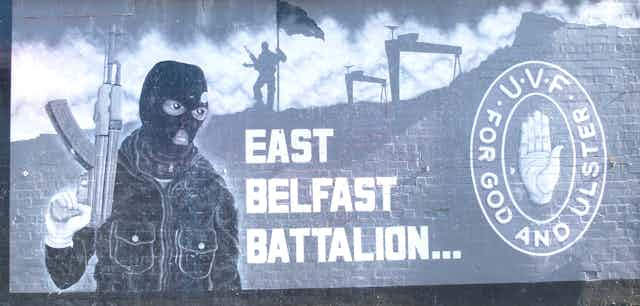Travel guides play an important part in attracting tourists to places. They help create expectations of an interesting, enriching experience, and different publishers provide different perspectives on local history and culture.
In these cash-strapped days, sponsored trips for travel writers are inevitable, but still, it’s not unreasonable to expect that travel guides should put a premium on authenticity and demonstrate independence from local marketing agencies and self-appointed guardians of a city’s image.
That ideal was recently crushed in Belfast when Fodor’s, one of the world’s most established travel publishers, caved in after the BBC ran a controversial story about its “offensive” guide to the city’s famous political murals.

After the story appeared, the publisher immediately dropped the guide from its website and confirmed it would remove it from the next print edition of Essential Ireland. The BBC report suggested the guide pandered to damaging, unhelpful and unfair stereotypes of unionists.
History of art
During the Troubles (and still today), murals served as territory markers, displaying the allegiances of an area or neighbourhood. As Bill Rolston, author of Drawing Support: Murals in the North of Ireland writes:
The political wall murals of the North of Ireland are an integral part of loyalist and republican communities. In its murals each group displays its hopes and fears, struggles and aspirations.
Now an established part of the iconography of the conflict in Belfast, it is understandable that BBC NI is interested in how this unique element of the city is portrayed to the world. These images of cultural conflict between Catholics and Protestant sit uneasily alongside the “new Belfast” – home to boutique hotels, Game of Thrones glamour, Titanic-themed attractions, alluring cuisine and a procession of international cruise ships.
This “post-conflict city” of today has moved on from the depictions 25 years ago in my book, Reimaging the Pariah City: Urban Development in Belfast and Detroit which likened efforts to putting “lipstick on a gorilla”.
Yet the old Belfast lurks with a certain menace, creating a frisson for dark tourism aficionados, but threatening to let the mask of normalcy slip. Here Fodor’s, drawing on local writers as is its policy, described this other city depicted on subway and gable walls.

Personal views
Some excerpts portray a flavour of what has been seen as problematic. In general, murals in unionist areas are derided as “comic-book like” while those in republican areas are “Sistine Chapel-lite”.
More specifically, Republican artwork is portrayed as:
…carrying themes of freedom from oppression, and a rising nationalist confidence that romantically and surreally mixes and matches images from the Book Of Kells, the Celtic mist mock-heroic posters of the Irish artist Jim Fitzpatrick, assorted phoenixes rising from the ashes and revolutionaries clad in splendidly idiosyncratic sombreros and bandanas from ideological battlegrounds in Mexico and South America.
By contrast, loyalist murals had taken on a “grimmer air”:
Typical subjects include wall-eyed paramilitaries perpetually standing firm against increasing liberalism, nationalism and all the other -isms Protestants see eroding their stern, Bible-driven way of life.
The ensuing uproar claimed that in this negative portrayal of Protestant culture, parity of esteem, a pillar of the Good Friday Agreement, had been breached.
Holding up a mirror
Fodor’s backed down when it should have stood its ground. Not only has it betrayed itself in caving so easily when challenged, but it has removed a mirror in which unionists need to take a long, hard look. The guide’s commentary depicts a narrow-minded, constipated, socially conservative image so often projected by political unionism in uncompromising rhetoric and backward-looking policy. Yes, it is brutal cultural comment, but not without a seed of truth.
This is exactly the image to which unionism must react, and lay to rest for good or face extinction. The case needs to be urgently made for the renewed future of the union in turbulent times. The Fodor’s characterisation picked up accurately the sense of optimism for a new agreed Ireland that runs through the Sinn Féin packaging of its history, past deeds and future intentions.
But unionism seemingly remains on the back foot, lacking the confidence to enter the fray. As Northern Irish historian Paul Bew stated recently, Brexit has opened up the union to a “new nationalist and separatist agenda” which unionism must respond to in kind. Unfortunately, without a call to intellectual and maybe artistic arms, unionism may be set to go the way of the dodo.
To avoid this, unionism must reimagine itself, thinking beyond and through a Sinn Féin projection of cultural superiority with its coolness to the notion of British-Irish identity. To engage effectively in cultural debate, unionism needs to have a strategy involving more than ad hoc reaction. Liberal unionism must reassert itself and express what it stands for, rather for what it is not. Staunch political unionist adherence to a past identity that resists “Irishness” has far outlived its usefulness and relevance.

Just as Black and British are not mutually exclusive identities, the argument that British and Irish are not mutually exclusive needs strong voices too. And not least because a siren call from the Republic of Ireland via Sinn Féin beckons unionists in uncertain Brexit times to join an evolving, forward-looking nation on a different European trajectory.
Any response must go beyond “saving the union for unionists”. Instead, political unionism in particular must make a case to the middle ground of Northern Catholic opinion, a place which carelessness and lack of vision has almost let slip away.
Unionism would do well to face up to how the images on Belfast walls are filtered – not decry this view with sour effrontery. It is an important filter through which their fellow British citizens see, and from which any tolerant agenda recoils. Reality is not so easily airbrushed.

